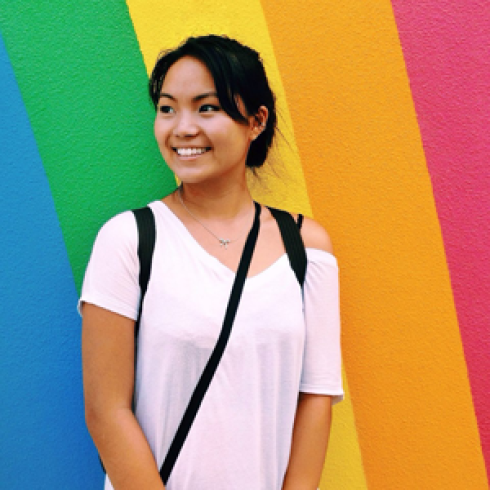Disproving the Japanese myth that idiots cannot catch colds, I fell sick for about a week during mid-October. It was a genuine joy to navigate the Japanese healthcare system, however, and I’ve never felt more at ease sitting in the waiting room at a clinic before. Everyone was nice, and accommodating, and I only had to pay about 30% of the total fee, thanks to my National Japanese Health Insurance card.
Ishikawa-san came with me, because I was even more useless than usual. Phrases like, ‘I have the chills’ and ‘I feel like I’m dying,’ are well outside of my current Japanese vocabulary.
I was prescribed rest, fluids, antibiotics and histamines, for what I assume was a regular cold. At the suggestion of my host mom, I wore the face masks people often associate with the considerate nature of Japanese culture. It’s used to keep one’s sickness to oneself, but can also be worn preemptively to ward off sickness on public transportation. However, I learned that you can’t wear the mask and the glasses because your exhalation fogs up the lenses with each breath. Thus, having to choose between courtesy and sight, I was forced to sort of walk slowly and cautiously wherever I went, and to squint aggressively at signs in order to read them. But all in all, I rested for a few days and recovered enough to attend the Narita Fireworks the following Sunday.
The e-pals, generous of time and spirit, agreed to help us put on yukata (summertime kimonos) in order to make the occasion more festive. Matsuri (festival) season usually ends in August, so I was relieved to have one last chance to wear a yukata before winter arrived. Luckily, my host-sister, who is 13, is roughly the same size as me (age 21) and allowed me to borrow her beautiful black yukata.
On the day of the festival, we all met in SALC (English Learning Center) and stood like mannequins as our e-pals busied themselves helping us get ready. I watched as Mariko-san walked around me in circles, folding, looping, typing, and cinching the fabric in place. I sucked my stomach in as she pulled my obi in tight against my ribcage, and attached the bow to the back, adjusting everything from head to toe. Finally, she set upon saving my hair from my messy-side braid, somehow wrangling all my loose strands into an elegant updo. I helped by passing her bobby pin after bobby pin, feeling her secure her hard work into place, before tugging out a few loose strands to frame my face.
The trek to Narita took about two hours by public transportation, and an added 45 minute walk to the rice field where the matsuri was taking place. The road was lined by street food vendors, and I soon had my hands full with a plate of yakisoba, okonomiyaki, and a chocolate covered banana. The rice field was muddy and soggy, so we shared what little tarp we had, and even used plastic bags to extend the radius of the seating area available. The fireworks started around 7:00p and ended at 7:45p with a finale more spectacular than anything I had ever seen in my entire life. It seemed like the entire sky was covered in glittering gold, and streaks of crimson shot across the night. After each explosion bloomed into a colorful array, the ground shook with the resounding boom that followed. We all sat, transfixed, our eyes glued to the fireworks show above our head, huddled together under the night sky.
It has always been my dream to wear a yukata in Japan, since I never had the chance to in Hawaii. As a child, I would watch the beautiful women in their yukatas dancing at obon festivals, wishing I could look just as elegant and refined. I loved how their footsteps padded softly, their strides restricted by the fabric around the ankles, and how their bows bobbed up and down behind them with each step. I would stare at their hair ornaments, swaying back and forth with each dance movement and wonder if I would ever get the chance to look like them.
When my e-pal, Naomi, met us on our way to Narita, she told me, “it suits you!” It’s strange how such a compliment can fill you with pride. Of course, this opportunity wouldn’t have been possible without the generosity of my host family and my Kanda friends, but there was a part of me that was so pleased that I looked natural. I wanted so badly to believe that wearing a yukata would make me feel more connected to my Japanese ancestry. And in a way, I think it did. Somehow, it didn’t even matter whether or not I matched the yukata, because it wasn’t the yukata that mattered. I understood the occasion. I loved the ambiance. I loved the process of getting ready and chatting with friends while someone helped do my hair. I loved the way I took little steps, but had to pick up the edge of the yukata to run to the bus stop with my friends. I loved the anticipation of watching the street vendor cook okonomiyaki in front of my eyes. I loved sitting under the fireworks with my friends, breathing in the crisp air, and welcoming the coming of fall together.

Emily Okikawa
<div>Emi Okikawa escaped from Oahu, Hawaii by hiding in the cargo hull of a plane headed for the East Coast. </div>
<div>She was last seen at Franklin & Marshall College in Lancaster, PA.</div>
<div>Recent rumors have surfaced about her being set loose in Tokyo. Be advised, the suspect has been spotted eating her weight in Japanese pastries and sitting in animal cafés for multiple hours a day.</div>








